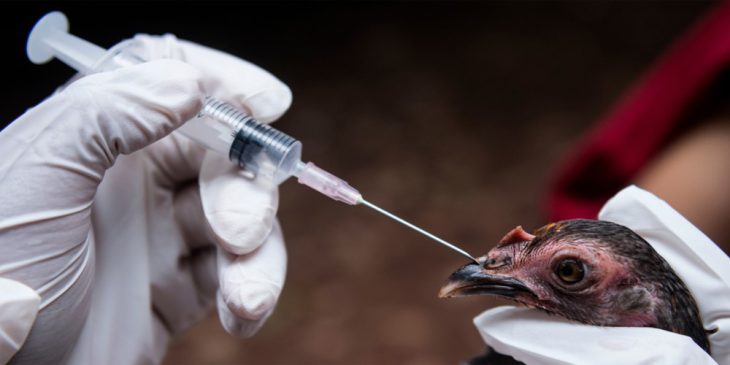In 2021, a research paper titled (Identification of genetic and biological characteristics of H7N9 avian influenza viruses after the use of H7N9 poultry vaccine in China) was published, in which it was introduced that the H7N9 avian influenza virus (AIV) that appeared in China caused became. The creation of 5 types of humanized agents and in September 2017 using the H7N9 vaccine in birds from cases to prevent its use. H7N9 strains are highly lethal to chickens and cause mild outbreaks in ducks.
The researchers of this article found that the AIV H7N9 isolated in 2019 is antigenically different from the H7N9 vaccine strain, so the proliferation of these viruses cannot be completely prevented in vaccinated chickens.
In the present study, we evaluated the genetic and biological properties of H7N9 HpAIV detected in Chinese birds between February 2018 and December 2019.
Influenza viruses easily undergo antigenic changes and as long as they circulate in nature, many variations of them appear.
H5/H7 oil emulsified vaccine based on Re-12, H5 Re-17, H7-Re2 viruses was previously reported and produced by Zeng et al. (journals.plos)
A research conducted by Xian-ying ZENG, Xin-wen HE et al. in 2022 in China under the title of protective efficacy of trivalent inactivated vaccine H5 / H7 (strains H5-Re13, H5-Re14 and H7-Re4) in chickens, ducks and geese against newly identified viruses H5N1, H5N6, H5N8 H7N9 Some H5 viruses isolated in poultry or wild birds between 2020 and 2021 are antigenically different from the vaccine strains (H5-Re11 and H5 -Re12) used in China and evaluated the protective efficacy of a new H5/H7 triple inactivated vaccine in chickens, ducks and geese. The inactivated vaccine was immunogenic and elicited significant antibody responses in test birds. Three weeks after vaccination, chickens were identified and challenged with five different viruses in 2020 and 2021: three viruses (H5N1 virus, H5N6 virus and H5N8 virus with HA gene 2.3.4.4b, one H5N6 virus with HA gene 2.3.4.4h and the H7N9 virus, after the investigations, they concluded that the vaccinated chickens are completely protected from the damage of the viruses. (ScienceDirect)
Newcastle disease (ND) is one of the worst diseases that severely cripples the poultry industry. ND disease is among the list of bird diseases that should be treated immediately. Newcastle disease is a highly contagious and often acute disease found in birds all over the world. This disease is caused by a super acute strain of type 1 paramyxovirus family. This disease occurs in three states: lentogenic or mild, mesogenic or moderate, and Vologenik or ultra-acute (known as Newcastle disease). Lentogenic strains are widely distributed in the world and rarely cause an outbreak. The symptoms of this disease are very similar to the flu, which is why clinical tests are very important for quick diagnosis. Vaccination is the best way to prevent disease, but unfortunately it is not done in all countries. This disease has been found in most countries and has continued to spread in different parts of Africa, Asia and South America. However, wild birds may be seen in different areas because they can be infected without symptoms and fly to different areas.
Among these vaccine strains, Lasota is clearly widely used in different countries due to its superior safety. Live B1-based ND vaccines may not be as immunogenic as Lasota, but due to its very weak characteristics, without Respiratory reactions are well known in birds.
Recent advances in DNA vaccines in recombinant DNA technology have made it possible to develop DNA vaccines by cloning a gene encoding an immunogen or a group of neutralizing epitopes into an expression plasmid.
Recombinant ND vaccines produced by gene replacement have been shown to induce protective immunity against virulent NDV challenge in chickens.
A recent strategy for the development of genotype-attenuated ND vaccines is reverse genetics, which recovers a recombinant virus from its cloned cDNA. Using this approach, Xiao et al genetically modified a highly virulent NDV circulating in Indonesia. and showed that it completely lost its pathogenicity and induced an extraordinary protective immunity that significantly reduced the virus after genotype challenge and even transformed into the highly virulent NDV VII.
To effectively control malignant NDV infection in birds, it is essential to quickly and specifically identify the etiologic agent. Currently, traditional virus isolation followed by serological or molecular confirmation is considered as the gold standard method for NDV diagnosis and pathotyping.
The biggest question among this diagnostic problem is (what is the best tool for rapid and accurate diagnosis of malignant NDV infection?) The answer to this question is the NGS method, which can identify all the signs of pathogenicity in the viral genome at a high speed.
An excellent NDV vaccine is that it not only prevents clinical disease, but also reduces viral replication.
As a result, the production of vaccines to prevent contamination in poultry is the priority of every country. (Hindaw)

Write Your Comment